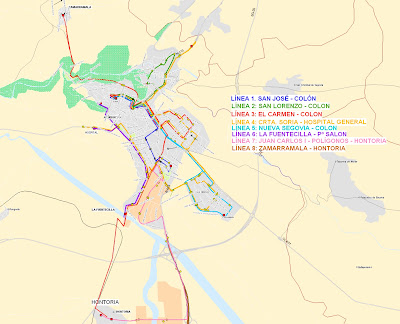Segovia through the years
I have been living here for only two months and I don't really know if the town is any different from before, but to talk about the change of Segovia through the years, I have asked many neighbours and explored through some webs to see what's going on.
In 1920, the population was much smaller than today. The total amount of people was 16.000, and by the 1980s, the population started to increase favorably and regularise. To be exact, the population by that moment was aproximately 53.000 in total. Nowadays, 52.000 people live in Segovia.

In the past, the conditions of the transport in the town were very poor. In fact, there was only a train station to travel abroad.
Nowadays, the transport has achieved a much better access. By 2004, the city had invented a new public transport service with urban and metropolitan buses with turistic and nighttime lines.
The weather is another thing that has changed over the past few years in the city.
Global warming affects every part of the planet, and so could tell the citizens from here. In the past, the winter was much colder and with big snowfalls and drastic low temperatures, and the summer had light temperatures.
Over the last decade, the temperatures have severally increased, forcing part of the especies of the area (including the community of Madrid and other close villages) to leave or even to extinguish.
Despite of those changes the city has suffered, Segovia is known to be a very traditional city that hasn't really changed at all, not even in economical, cultural or social aspects that could be considered.
In 1920, the population was much smaller than today. The total amount of people was 16.000, and by the 1980s, the population started to increase favorably and regularise. To be exact, the population by that moment was aproximately 53.000 in total. Nowadays, 52.000 people live in Segovia.

In the past, the conditions of the transport in the town were very poor. In fact, there was only a train station to travel abroad.
Nowadays, the transport has achieved a much better access. By 2004, the city had invented a new public transport service with urban and metropolitan buses with turistic and nighttime lines.
The weather is another thing that has changed over the past few years in the city.
Global warming affects every part of the planet, and so could tell the citizens from here. In the past, the winter was much colder and with big snowfalls and drastic low temperatures, and the summer had light temperatures.
Over the last decade, the temperatures have severally increased, forcing part of the especies of the area (including the community of Madrid and other close villages) to leave or even to extinguish.
Despite of those changes the city has suffered, Segovia is known to be a very traditional city that hasn't really changed at all, not even in economical, cultural or social aspects that could be considered.



Comentarios
Publicar un comentario